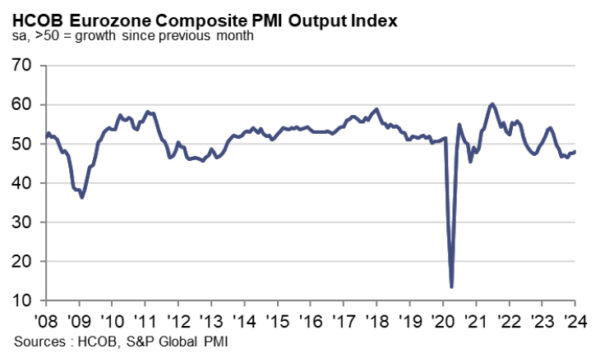Eurozone PMI services finalized at 48.4, Southern strength versus Northern softness
A closer look at the Eurozone PMI data
The Eurozone Purchasing Managers’ Index (PMI) for services was finalized at 48.4 in January, a slight decrease from December’s 48.8. The Composite PMI, which includes both manufacturing and services, was finalized at 47.9, up from the prior month’s 47.6 and reaching a 6-month high. However, what is particularly interesting about the latest PMI data is the clear divide between the northern and southern economies within the Eurozone.
The “north-south divide”
The data reveals a striking contrast between the performance of southern European countries like Spain and Italy, and their northern counterparts like Germany. Spain and Italy reported Composite PMIs of 51.5 and 50.7 respectively, indicating strong growth in both manufacturing and services sectors. On the other hand, Germany’s Composite PMI was lower at 47.0, signaling a slowdown in economic activity.
This unexpected trend challenges conventional perceptions about the economic dynamics within the Eurozone. While Germany is often seen as the powerhouse driving growth in the region, the latest PMI data suggests that southern countries are currently outperforming their northern peers.
Impact on me
As a resident of the Eurozone, the divergence in economic performance between northern and southern countries could have implications for me. If the trend continues, it could lead to shifts in investment patterns, job opportunities, and overall economic stability within the region. It is important to stay informed about these developments and adapt accordingly to navigate any potential challenges or opportunities that may arise.
Impact on the world
The contrasting performance of southern and northern Eurozone economies also has broader implications for the global economy. As the Eurozone is a significant player in the international market, any fluctuations in its economic performance can have ripple effects on global trade, investment, and growth. Observing the north-south economic divide within the Eurozone can provide valuable insights into the overall health of the world economy.
Conclusion
The latest Eurozone PMI data paints a complex picture of economic trends within the region, highlighting a surprising strength in southern countries compared to their northern counterparts. As we continue to monitor these developments, it is essential to consider the potential implications for individuals, businesses, and the global economy as a whole. Adaptability and awareness will be key in navigating the evolving economic landscape.





